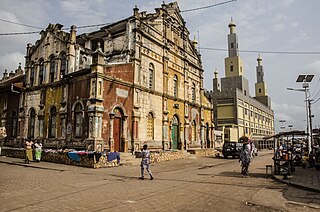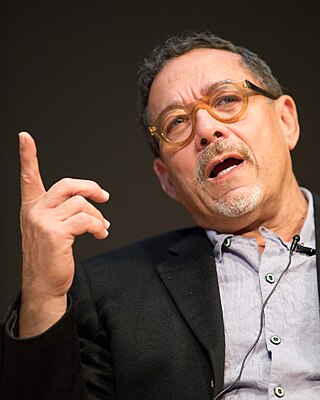
Benin, officially the Republic of Benin, is a country in West Africa. It was formerly known as Dahomey. It is bordered by Togo to the west, Nigeria to the east, Burkina Faso to the north-west, and Niger to the north-east. The majority of its population lives on the southern coastline of the Bight of Benin, part of the Gulf of Guinea in the northernmost tropical portion of the Atlantic Ocean. The capital is Porto-Novo, and the seat of government is in Cotonou, the most populous city and economic capital. Benin covers an area of 112,622 km2 (43,484 sq mi), and its population in 2021 was estimated to be approximately 13 million. It is a tropical country with an economy heavily dependent on agriculture, and is an exporter of palm oil and cotton.

Porto-Novo is the capital and second-largest city of Benin. The commune covers an area of 110 square kilometres (42 sq mi) and as of 2002 had a population of 223,552 people.
Ouidah or Whydah, and known locally as Glexwe, formerly the chief port of the Kingdom of Whydah, is a city on the coast of the Republic of Benin. The commune covers an area of 364 km2 (141 sq mi) and as of 2002 had a population of 76,555 people.

Edouard Duval-Carrié is a Haitian-born American contemporary painter and sculptor based in Miami, Florida.

Georges Adéagbo is a Beninese sculptor known for his work with found objects.
Frédéric Bruly Bouabré, also known as Cheik Nadro, was an Ivorian artist.
Calixte Dakpogan is a Beninese sculptor known for his installations as well as his masks made out of diverse and original found materials. A native of Pahou, he currently lives and works in Porto Novo. Much of his work is inspired by his Vodun heritage.

Christianity is the largest religion in Benin, with substantial populations of Muslims and adherents of traditional faiths such as Vodún.

Francisco Félix de Souza was a Brazilian slave trader who was deeply influential in the regional politics of pre-colonial West Africa. He founded Afro-Brazilian communities in areas that are now part of those countries, and went on to become the "chachá" of Ouidah, a title that conferred no official powers but commanded local respect in the Kingdom of Dahomey, where, after being jailed by King Adandozan of Dahomey, he helped Ghezo ascend the throne in a coup d'état. He became chacha to the new king, a curious phrase that has been explained as originating from his saying "(...) já, já.", a Portuguese phrase meaning something will be done right away.

Manuel Mendive Hoyos is an Afro-Cuban artist.
Cyprien Tokoudagba was a Beninese sculptor and painter. He was from Abomey, Benin.
The following is a timeline of the history of the city of Cotonou, Benin.

Vodun art is associated with the West African Vodun religion of Nigeria, Benin, Togo and Ghana. The term is sometimes used more generally for art associated with related religions of West and Central Africa and of the African diaspora in Brazil, the Caribbean and the United States. Art forms include bocio, carved wooden statues that represent supernatural beings and may be activated through various ritual steps, and Asen, metal objects that attract spirits of the dead or other spirits and give them a temporary resting place. Vodun is assimilative, and has absorbed concepts and images from other parts of Africa, India, Europe and the Americas. Chromolithographs representing Indian deities have become identified with traditional Vodun deities and used as the basis for murals in Vodun temples. The Ouidah '92 festival, held in Benin in 1993, celebrated the removal of restrictions on Vodun in that country and began a revival of Vodun art.
The International Festival of Vodun Arts and Cultures, also known as the Ouidah Festival, was first held in Ouidah, Benin in February 1993, sponsored by UNESCO and the government of Benin. It celebrated the transatlantic Vodun religion, and was attended by priest and priestesses from Haiti, Cuba, Trinidad and Tobago, Brazil and the United States, as well as by government officials and tourists from Europe and the Americas. The festival was sponsored by the newly elected president of Benin, Nicéphore Soglo, who wanted to rebuild the connection with the Americas and celebrate the restoration of freedom of religion with the return to democracy. Artists from Benin, Haiti, Brazil and Cuba were given commissions to make sculptures and paintings related to Vodun and its variants in Africa and the African diaspora.
Dominique "Kouas" Gnonnou is a contemporary Beninese artist and sculptor of Vodun art.
Simonet Biokou is a contemporary Beninese scrap metal artist. He has also appeared in film, playing himself in the 1998 film Divine Carcasse, in which his character is shown creating a sculpture using car parts. His works have been featured in major metropolitan museums including the Metropolitan Museum in New York.
Yves Apollinaire Pede (1959–2019) was a Beninese voodoo artist. After being commissioned to reproduce reliefs for the Abomey Museum, he made sand paintings of well-known personalities such as Nelson Mandela. He gradually became oriented towards textile art, looking to Haitian and Cuban Vodou artists for inspiration. He is also noted for his large cement sculptures and bas-reliefs, and is stated to have a "special interest" in Kulito, a Fon word which literally means "the one from the path of death".
Marie-Cécile Zinsou is a French-Beninese art historian and entrepreneur, She is president of the Fondation Zinsou, founded in 2005 in Cotonou, Republic of Benin which promotes contemporary art in Africa and leads cultural, educational and social initiatives. In 2014 she opened the first museum of contemporary art in Benin.
Jean-Dominique Burton, born on 13 October 1952 in Huy (Belgium), is a Belgian photographer and filmmaker, author of several books of photographs focusing on Europe, Asia and Africa. Since 1978, numerous exhibitions have been dedicated to his work, in Europe, Africa, North America and Asia. Many of his works have also been included in public and private collections.






